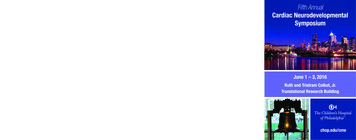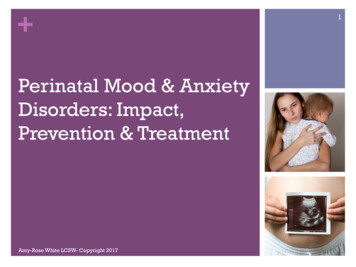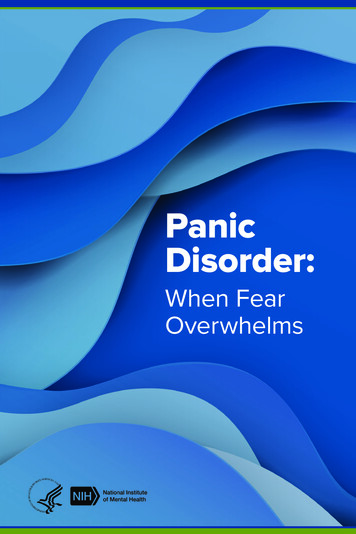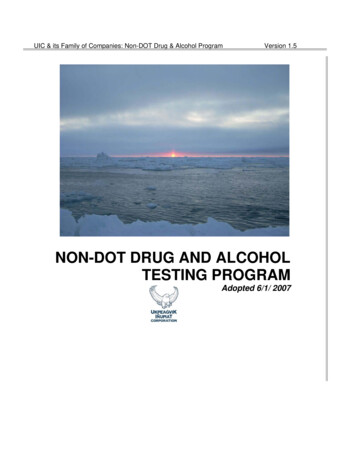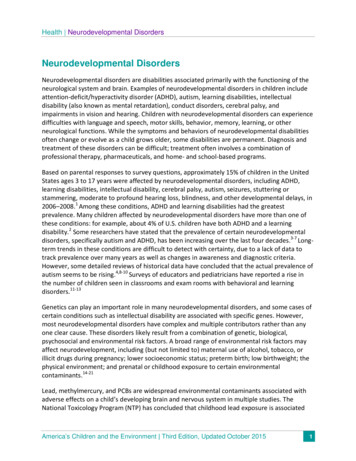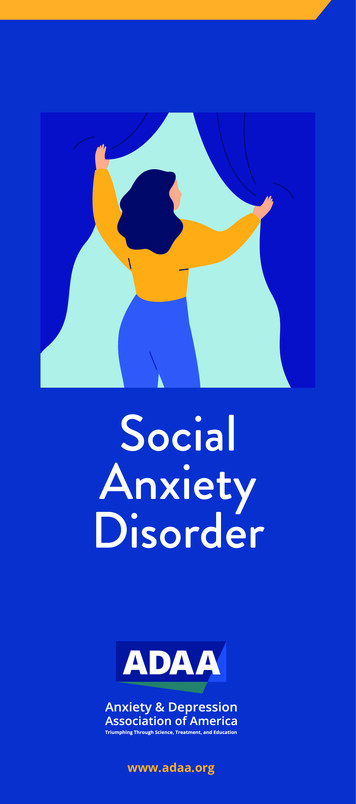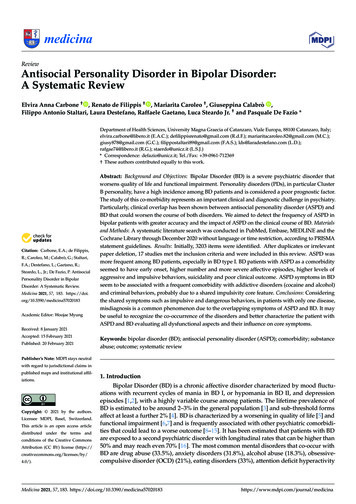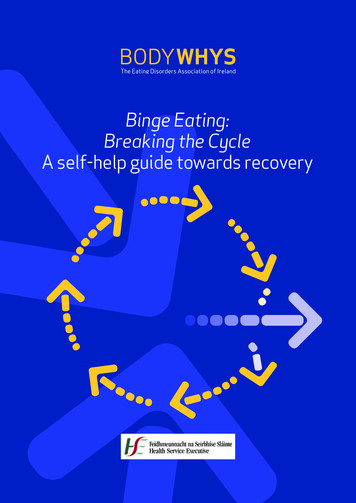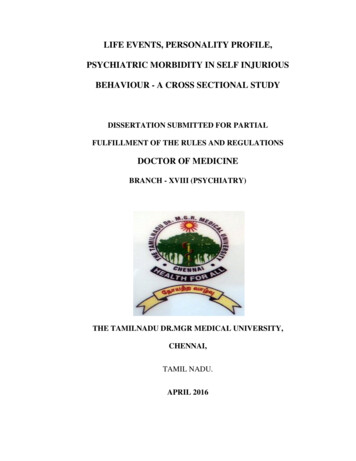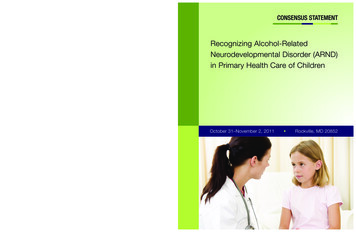
Transcription
Consensus StatementRecognizing Alcohol-RelatedNeurodevelopmental Disorder (ARND)in Primary Health Care of ChildrenOctober 31–November 2, 2011Initiative of theDiagnostic Issues Work GroupInteragency Coordinating Committee on Fetal Alcohol Spectrum DisordersSponsored by theInteragency Coordinating Committee on Fetal Alcohol Spectrum DisordersNational Institute on Alcohol Abuse and Alcoholism, National Institutes of HealthCenters for Disease Control and PreventionAmerican Academy of Pediatrics Rockville, MD 20852
Consensus Statement onRecognizing Alcohol-Related Neurodevelopmental Disorder(ARND) in Primary Health Care of ChildrenA Conference Organized by the Interagency Coordinating Committee onFetal Alcohol Spectrum Disorders (ICCFASD)Oct. 31–Nov. 2, 2011, Rockville, MDIntroductionThe nondiagnostic umbrella term “fetal alcohol spectrum disorders (FASD)” is now used tocharacterize the full range of damage from prenatal alcohol exposure, varying from mild tosevere and encompassing a broad array of physical defects and cognitive, behavioral, emotional,and adaptive functioning deficits. FASD includes diagnoses such as fetal alcohol syndrome(FAS), partial FAS (pFAS), ARND, and alcohol-related birth defects (ARBD), which arecongenital anomalies including malformations and dysplasias of the cardiac, skeletal, renal,ocular, auditory, and other systems.The negative effects of prenatal alcohol exposure on the developing brain and the resultingneurological and/or cognitive, behavioral, emotional, and adaptive functioning deficits are seenin individuals with FAS, pFAS, and ARND. Significant alcohol exposure early in prenataldevelopment often results in growth retardation and facial anomalies. These physicalcharacteristics have been useful tools for diagnosing FAS and pFAS. Identifying persons who donot have the physical characteristics of FAS but do have neurodevelopmental disorders inducedby prenatal alcohol exposure has proven to be much more challenging, with broad implications.Current prevalence estimates for FAS range from 0.5 to 7 cases per 1,000 live births in theUnited States, and the prevalence of FAS and ARND combined is thought to be three times thatof FAS alone.In 2004, the National Center on Birth Defects and Developmental Disabilities of the Centers forDisease Control and Prevention and the National Task Force on FAS and Fetal Alcohol Effectissued Guidelines for Referral and Diagnosis of FAS. Evidence for recommending screening andreferral for diagnosis of ARND was considered insufficient at that time. In the past 7 years, alarge body of research evidence has been published on further characterization anddifferentiation of the cognitive, behavioral, emotional, and adaptive functioning deficits1
associated with prenatal alcohol exposure. Based on this evidence and identification of theprincipal issues with researchers and clinicians, ICCFASD determined that the time had come toreassess whether sufficient evidence now existed to recommend screening and/or referral fordiagnosis of ARND in primary health care of children. ICCFASD then proceeded to convene aconference during which a multidisciplinary panel would respond to the principal issues, with theobjective of arriving at a statement that would advance an understanding of the issue and thatwould be useful to health care professionals. This document summarizes the outcome of theconference.ProcessIn late 2011, ICCFASD assembled a broad-based, independent panel of knowledgeable andunbiased critical thinkers to hear and evaluate evidence presented by experts in the field ofFASD. The goal of the conference was to arrive at recommendations and future directions onwhether to encourage screening and diagnosis (or referral for diagnosis) of ARND in primaryhealth care of children.The consensus statement that follows was prepared by the panel, which included health careprofessionals, biomedical researchers, academics, educators, and child advocate/policy/legalrepresentatives. It is based on (1) relevant published studies assembled by the scientificcommittee of the conference, (2) presentations of data from the peer-reviewed scientificliterature by experts working in areas relevant to the conference questions, (3) questions andcomments from conference attendees during open discussion periods, and (4) closeddeliberations by the panel. This statement is an independent report of the panel and is not apolicy statement of ICCFASD or the National Institute on Alcohol Abuse and Alcoholism,National Institutes of Health; the Centers for Disease Control and Prevention; or the AmericanAcademy of Pediatrics, which cosponsored the conference.Conference QuestionsThe panel used the evidence presented to them by the experts in the field to develop answers, inthe form of a consensus statement, to the following questions:1. What is ARND; how can it be diagnosed (classical, current diagnostic schemes, in practicetoday)?Part A: Evidence of Central Nervous System Developmental AbnormalitiesPart B: Evidence of a Complex Pattern of Behavior and Cognitive Abnormalities2. Can ARND be differentiated from other disorders?3. What prenatal alcohol exposure evidence is necessary for an ARND diagnosis?4. What signs/symptoms will be useful as screening criteria?5. What are the treatment needs for those diagnosed with ARND?2
PreambleChildren, adults, and families who live with disabilities related to prenatal alcohol exposure(PAE) face extraordinary challenges daily. The work of clinicians and researchers who haveworked to understand and improve outcomes on their behalf must be commended. Together, thiscommunity has pioneered medical, educational, social, and scientific initiatives, all in pursuit ofimproving the quality of life for those affected and their families and of reducing the publichealth burden resulting from PAE.PAE can cause significant neurodevelopmental and behavioral disorders as well as adaptive andself-regulatory impairments that can have lifelong consequences. Early diagnosis andintervention may help to reduce the long-term challenges potentially facing individuals withPAE. Therefore, primary health care clinicians serving children 1 should be alert to evidence ofany maternal use of alcohol during pregnancy in order to provide timely evaluations andappropriate interventions for affected children and help prevent PAE during future pregnancies.Question 1: What is ARND; how can it be diagnosed (classical, currentdiagnostic schemes, in practice today)?Alcohol-related neurodevelopmental disorder (ARND) refers to a complex range of disabilitiesin neurodevelopment and behavior, adaptive skills, and self-regulation in the presence ofconfirmed PAE. ARND is one of the fetal alcohol spectrum disorders that also include fetalalcohol syndrome (FAS), which is additionally characterized by distinct facial features andgrowth retardation.The term ARND was used in a 1996 report developed under the auspices of the Institute ofMedicine (IOM) 2 to recognize the existence of neurodevelopmental disorders associated withconfirmed PAE. Specifically, individuals with ARND do not present with the FAS facialphenotype (reduced palpebral fissure length, smooth philtrum, and thin upper vermillion border),but may present with structural and/or functional central nervous system (CNS) abnormalities,and may or may not present with growth deficiencies or decreased cranial size at birth.Acknowledging some degree of uncertainty that PAE caused the presenting adverse effects inany particular individual, the 1996 IOM report on FAS defined ARND as CNSneurodevelopmental abnormality evidenced by decreased cranial size at birth, or structural brain1Primary health care clinicians for children include pediatricians, pediatric nurse practitioners, familymedicine physicians, family nurse practitioners, pediatric and family physician assistants, and certainnurses in public health clinics or school-based health clinics.2Stratton K, Howe C, Battaglia F. (Eds.) Fetal alcohol syndrome: Diagnosis, epidemiology, prevention,and treatment. Washington, DC: National Academies Press, 1996. Available online at:http://www.nap.edu/openbook.php?isbn 0309052920.3
abnormalities, or neurological hard or soft signs in the presence of a pattern of confirmedexcessive maternal prenatal alcohol use. Alternatively, ARND could be defined by evidence of acomplex pattern of behavioral and cognitive abnormalities that are inconsistent withdevelopmental level and cannot otherwise be explained by the genetic contribution of thebiological parents, nor by impairments in brain maturation conferred by adverse environmentalfactors. Alternative descriptors have emerged, including “neurodevelopmental disorder/alcoholexposed” and “static encephalopathy/alcohol exposed.” 3 In the ensuing years, animal researchand human studies have helped families, clinicians, and researchers develop a deeperunderstanding of the relationship between PAE and neurodevelopmental manifestationssubsequently evident in children, adolescents, and adults.Part A: Evidence of CNS Developmental AbnormalitiesThe brain is susceptible to the neurotoxic effects of alcohol at all stages of gestation. Based onextensive, mutually reinforcing animal and clinical research, there appear to be patterns ofsignificant structural and functional changes in the CNS attributable to PAE. Basic researchsuggests that numerous processes of neuronal development and functioning can be affected byPAE. Animal studies demonstrate that the timing, dose, and frequency of PAE differentiallyharm specific neuronal structures and brain circuits. Brain imaging and cognitive and behavioralstudies have substantiated similar structural and functional alterations in humans.Part B: Evidence of a Complex Pattern of Behavior and Cognitive AbnormalitiesThere is clear and compelling evidence from animal studies that PAE negatively affectsbehavior, cognition, motor function, self-regulation and adaptive function, executive function,activity, and mood in a complex way. Children with PAE frequently exhibit behavioral andemotional problems such as inattention, hyperactivity, anxiety, and mood dysregulation. Theseproblems may emerge early in life and continue to significantly impair an individual’sfunctioning in numerous domains throughout the lifespan. Identified problems may be primary toPAE, be primary to a comorbid condition, or result from the contribution of and interactionamong a number of factors, including interactions with the environment. Research with childrensuggests that PAE can be associated with general cognitive impairments and specificimpairments in the following areas: information processing, attention, executive function,language, memory/learning, social cognition, number processing, and sensorimotor function.One or more behavioral and cognitive phenotypes specific to PAE have been elusive.Identification of specific phenotypes is confounded by variability of exposure (dose, duration,and timing) and potential interactions among other factors, which may include qualities of theprenatal and postnatal environments, genetics, and exposure to other toxic substances.3Currently, there are several commonly accepted diagnostic schemes and interpretations of thediagnostic guidelines presented in the 1996 IOM report on FAS (see Resources for Further Informationand Application at the end of this statement for commonly accepted diagnostic schemes providingguidelines on diagnosing ARND). This panel is not advocating any particular system for the diagnosis ofARND or the use of these alternate descriptors.4
Question 2: Can ARND be differentiated from other disorders?Alcohol is a known teratogen and is strongly associated with a range of neurodevelopmental andbehavioral disorders that may affect numerous domains of functioning across the lifespan.Emerging evidence from animal and human studies suggests that there is a constellation ofsymptoms attributable to PAE that may include (1) neurocognitive impairments, (2) selfregulatory challenges, and (3) impairments in adaptive functioning. However, differentiatingARND from other complex neurodevelopmental disorders can be challenging due to limitedavailable studies attempting to distinguish ARND phenotype(s) from other disorders.Even when a history of PAE is available, diagnosing ARND and distinguishing it from othercomplex developmental disorders requires prudent clinical judgment and consideration of otherpotential causes. In the future, we anticipate that clinicians will be assisted in making thisdiagnosis through advances in the identification of biomarkers sensitive to the detection ofsignificant PAE and the development of tests that are both sensitive to and specific for alcoholinduced neurobehavioral disorders. We recommend additional rigorous scientific investigation tofurther refine understanding of the cognitive, behavioral, neurologic, and psychiatric clinicalprofiles attributable to PAE, as well as of the patterns of development evidenced by individualswith PAE. We further recommend that investigations of other complex developmental disordersinclude inquiry about PAE to identify the contribution of PAE to the phenotypes of otherdevelopmental disorders.Question 3: What prenatal alcohol exposure evidence is necessary for anARND diagnosis?An ARND diagnosis requires confirmed, significant PAE. Determination of alcohol exposurecan be based on maternal self-report; the report of a spouse, partner, relative, or friend whoobserved the birth mother drinking alcohol during the index pregnancy; and/or documentation inmedical or other records about maternal alcohol use during the index pregnancy.Data from animal studies across multiple species confirm that, at the highest levels of alcoholexposure in the first trimester, facial abnormalities and brain maldevelopment occur in concert.However, alterations in brain development that subsequently affect behavior can occur with arange of alcohol dosages throughout gestation, even when the face and brain appear to bestructurally normal. Variable patterns of maternal drinking, including binge drinking resulting insignificant peak levels or sustained drinking resulting in significant cumulative exposures, maylead to differential fetal outcomes. In addition, evidence suggests that variability in both maternaland fetal characteristics affects the potential for alcohol-induced alterations in brain5
development. Thus, because there is no known safe threshold for PAE, it is not currently possibleto define a safe limit of alcohol consumption during pregnancy. 4Question 4: What signs/symptoms will be useful as screening criteria?The U.S. Surgeon General recommends regular screening of every woman of childbearing agefor alcohol use. Screening should be conducted by adult primary health care clinicians andobstetric caregivers to protect the health of women and any subsequent offspring. For children,pediatric primary health care clinicians should obtain medical records about PAE and otherpotential risks from the birth mother’s obstetric caregiver. For children who are not living withtheir birth parents, clinicians should obtain any available records that may provide informationabout PAE or other relevant family history. Clinicians should query families in a nonjudgmentalway about all risks to a child’s development, including maternal alcohol use prior to and duringpregnancy. We recommend that clinicians be trained regarding the most effective ways to askabout alcohol use to ensure that this practice is adopted as routine. 5 Regular screening of parentalalcohol use should continue as part of the process of child health supervision and developmentalsurveillance.If PAE is confirmed, primary care clinicians should be alert for signs and symptoms that canoccur during the child’s development. Primary care clinicians should complete a comprehensivehistory for any child at risk for ARND that includes questions about developmental milestones,school functioning, peer and family relationships, adaptive and self-help skills, and specific areasof impairment, and they also should conduct a physical and neurological examination. A concernidentified in any of these areas warrants a referral for a complete evaluation and followup.Absence of a concern should result in continued developmental surveillance of the child, asproblems related to PAE may emerge during maturation, particularly during adolescence andyoung adulthood when latent ARND as well as other comorbidities commonly arise.Question 5: What are the treatment needs for those diagnosed with ARND?Given that the manifestations of PAE are heterogeneous, vary across development, and can belifelong, treatment plans need to be multimodal and specific to the strengths and weaknesses ofthe affected individual and family across the lifespan. Treatment begins with support of theaffected individual and family and education on the manifestations of ARND, risks for other4The 1996 IOM report on FAS describes necessary or required confirmed alcohol exposure as “a patternof excessive intake characterized by substantial, regular intake or heavy episodic drinking. Evidence ofthis pattern may include frequent episodes of intoxication, development of tolerance or withdrawal, socialproblems related to drinking, legal problems related to drinking, engaging in physically hazardousbehavior while drinking, or alcohol-related medical problems such as hepatic disease.” New data areaccumulating to suggest that ARND can occur at lower levels of alcohol exposure than indicated in the1996 IOM report.5See Resources for Further Information and Application at the end of this statement for a list ofcommonly used screening tools for parental alcohol use.6
problems, and available treatments. Treatments should draw on evidence-based practices as theypertain to an individual’s specific needs. Treatment should be implemented flexibly, but withfidelity, in addressing the specific developmental strengths and weaknesses of the individual andfamily. Modifications of evidence-based treatments should only be considered when thosetreatments have been implemented with integrity over an adequate period of time and have failedto yield improvement.Some interventions for ARND have targeted common manifestations of PAE, includingproblems with mathematics, attention, self-regulation, adaptive functioning and problem-solving,social impairment, and working memory. Other interventions have focused on individual andgroup-based skills development or training of caregivers in behavior management. Large, wellcontrolled behavioral intervention studies specific to ARND are needed. First, studies are neededto determine whether currently available evidence-based interventions for problems common tochildren without PAE yield similar benefits in children with ARND. Second, when evidenceindicates a reduced or inadequate benefit, modifications of existing interventions or developmentof entirely new interventions need to be completed and evaluated. In addition, these researchobjectives also may be accomplished by assessing for PAE those participants with other mentalhealth disorders and developmental disabilities in treatment outcome studies. Finally, thesestudies should target children across the developmental spectrum, with special attention directedat the periods of challenging transitions from childhood to adolescence and from adolescence toadulthood.Some medications have been shown to effectively treat emotional and behavioral problems inchildren. Although there is an impression that many of these medications may be less effective inchildren with PAE or may lead to an atypical response, the literature is sparse and inconclusive.High-quality randomized controlled trials of medication treatments are needed for individualsacross the lifespan in order to identify which medications work best for the specific problemsaffecting individuals with ARND.Many of the problems experienced by children with PAE manifest as academic impairments orother problems at school. Given the limited number of educational interventions specific tochildren with ARND, clinicians may need to draw on evidence-based educational interventionsfor other disorders. For any school-based educational, medical, or mental health intervention, itis particularly important to engage educators, school health and mental health professionals, andother staff in assessing, planning, and implementing the intervention with high fidelity toenhance the effectiveness of the specific intervention plan.Problems in self-regulation and social and adaptive functioning can manifest as early as infancyand continue throughout the lifespan. For young children, it is important to educate caregiversand early intervention providers about the manifestations of ARND as well as the usefulness ofspecific intervention strategies for this age group. In addition, individuals with ARND can havepoor decision-making skills, placing them at risk for a range of behavioral problems that may7
lead to contact with school-based professionals and other community service providers who maybe unaware of how ARND can affect a child’s functioning. It is therefore important to helpaffected individuals and families become self-advocates and to broadly educate the public andrelevant professionals about behavior problems associated with ARND.In conclusion, children and youth with PAE have a Special Health Care Need 6 and should haveongoing developmental and behavioral surveillance by their primary health care clinician in a“medical home.” 7 This surveillance should continue throughout their lifespan to assess ongoingtreatment and referral needs.6As adopted in 1998 by the American Academy of Pediatrics (AAP), children with Special Health CareNeeds are those who have or are at increased risk for a chronic physical, developmental, behavioral, oremotional condition and who also require health and related services of a type or amount beyond thatrequired by children generally. This definition originally was proposed in McPherson M, Arango P, FoxHB. A new definition of children with special health care needs. Pediatrics. 1998;102:137–40.7The AAP defines a “medical home” as one in which the care of infants, children, and adolescents isdelivered or directed by well-trained physicians who provide primary care and help to manage andfacilitate essentially all aspects of pediatric care. The physician should be known to the child and familyand should be able to develop a partnership of mutual responsibility and trust with them. Ideally, care isaccessible, continuous, comprehensive, family centered, coordinated, compassionate, and culturallyeffective. The Affordable Care Act of 2010 endorses the medical home model throughout the lifespan. Formore information, see ull/pediatrics;110/1/184.8
Resources for Further Information and ApplicationCommonly Accepted Diagnostic Schemes Providing Guidelines on Diagnosing ARND:Astley SJ. Diagnostic guide for fetal alcohol spectrum disorders: The 4-digit diagnostic code.3rd ed. Seattle, WA: University of Washington Publication Services, 2004. Available online 04.pdf.Chudley AE, Conry J, Cook JL, Loock C, Rosales T, LeBlanc N. Fetal alcohol spectrumdisorder: Canadian guidelines for diagnosis. Can. Med. Assoc. J. 172(5 Suppl.):S1–S21, 2005.Available online at: http://www.cmaj.ca/content/172/5 suppl/S1.full.Hoyme HE, May PA, Kalberg WO, Kodituwakku P, Gossage JP, Trujillo PM, et al. A practicalclinical approach to diagnosis of fetal alcohol spectrum disorders: Clarification of the 1996Institute of Medicine criteria. Pediatrics. 115(1), 39–47, 2005. Available online 15/1/39.full.pdf html.Stratton K, Howe C, Battaglia F. (Eds.) Fetal alcohol syndrome: Diagnosis, epidemiology,prevention, and treatment. Washington, DC: National Academies Press, 1996. Available onlineat: Commonly Used Screening Tools for Screening Men and Women for Alcohol Use:National Institute on Alcohol Abuse and Alcoholism. Helping patients who drink too much: Aclinician’s guide: Updated 2005 edition. Bethesda, MD: National Institutes of Health.Publication No. 07-3769, 2007. Available online TrainingMaterials/Pages/guide.aspx. (Relatedresources, most of which are available online only, include professional support resources,manuals, forms, and a slide show. An online training is approved for continuing medicaleducation/continuing education credit.)Other Alcohol Screening Instruments Recommended for Use With Women:Barry KL, Caetano R, Chang G, DeJoseph MC, Miller LA, O’Connor MJ, et al., National TaskForce on Fetal Alcohol Syndrome and Fetal Alcohol Effect. Reducing alcohol-exposedpregnancies: A report of the National Task Force on Fetal Alcohol Syndrome and Fetal AlcoholEffect. Atlanta, GA: Centers for Disease Control and Prevention, March 2009.Available online at: reg.pdf.9
AcknowledgmentsConference Moderator Tom Donaldson, Chief Executive Officer and President, NationalOrganization on Fetal Alcohol Syndrome, Washington, DC, maintained the smooth conduct ofthe meeting, ensuing ample opportunity for speaker presentations and scheduled discussions.Expert Chair Claire D. Coles, Ph.D., Professor, Departments of Psychiatry and BehavioralSciences and Pediatrics, Emory University School of Medicine; Director, Fetal Alcohol andDrug Exposure Center, Marcus Autism Center, Atlanta, GA, led the assembled expertsin presenting the available scientific and clinical evidence on ARND to the panel duringpublic sessions.Panel MembersChairperson Joseph F. Hagan, Jr., M.D., FAAP, Pediatrics Clinical Professor, University ofVermont College of Medicine and the Vermont Children’s Hospital, Burlington, VT; Co-Editorof Bright Futures Guidelines for Health Supervision of Infants, Children and Adolescents, ThirdEdition; and Chair, American Academy of Pediatrics Committee on Psychosocial Aspects ofChild and Family Health, led a distinguished panel of specialists knowledgeable aboutdevelopmental disorders to craft a consensus statement with practical recommendations based onthese questions.Steven W. Evans, Ph.D., Professor and Co-Director, Center for Intervention Research inSchools, Ohio University, AthensEva J. Klain, J.D., Director, Child and Adolescent Health, Center on Children and the Law,American Bar Association, Washington, DCBarry Kosofsky, M.D., Ph.D., Goldsmith Foundation Professor of Pediatrics and Chief,Division of Pediatric Neurology, New York-Presbyterian Hospital/Weill Cornell Medical Center,New York, NYElizabeth B. Kozleski, Ed.D., Professor, School of Social Transformation, Arizona StateUniversity, TempePaul Lipkin, M.D., Director, Center for Development and Learning, Kennedy Krieger Institute,Baltimore, MD; Associate Professor, The Johns Hopkins University School of Medicine,Baltimore, MDJoyce Maring, Ed.D., PT, Associate Professor, Director of Physical Therapy Program andInterim Chair, Physical Therapy and Health Care Sciences, The George Washington UniversitySchool of Medicine and Health Sciences, Washington, DC10
Rita H. Pickler, Ph.D., RN, PNP-BC, FAAN, Nurse Scientist, Center for ProfessionalExcellence and Perinatal Institute and Cincinnati Children’s Hospital Medical Center, Ohio;Professor Emerita, Virginia Commonwealth University, Richmond, VA; Adjunct Faculty,University of Cincinnati, Ohio; Research Professor, Ohio State University, CincinnatiLisa Albers Prock, M.D., M.P.H., FAAP, Assistant Professor, Harvard Medical School,Boston, MA; Director, Developmental Medicine Center, Children’s Hospital Boston,MassachusettsEdward P. Riley, Ph.D., Distinguished Professor and Director of the Center for BehavioralTeratology, San Diego State University, CaliforniaJohn T. Walkup, M.D., Director, Division of Child and Adolescent Psychiatry, Weill CornellMedical College, New York, NY; Adjunct Professor, The Johns Hopkins Center for AmericanIndian Health, Baltimore, MDCarol Weitzman, M.D., Associate Professor, Pediatrics and Child Study Center; Director,Developmental and Behavioral Pediatrics; Program Director, Fellowship in Developmental andBehavioral Pediatrics, Yale University School of Medicine, New Haven, CTKimberly Yolton, Ph.D., Associate Professor, Division of General and Community Pediatrics,Cincinnati Children’s Hospital Medical Center, Ohio11
Speakers and TopicsOverview of TopicAlcohol-Related Neurodevelopmental Disorder (ARND): Clinical and Empirical Evidencefor an Independent Effect on BehaviorClaire D. Coles, Ph.D., Professor, Department of Psychiatry and Behavioral Science andPediatrics, Emory University School of Medicine; Director, Fetal Alcohol Program, MarcusAutism CenterQuestion 1: What is ARND and how is it diagnosed (classical, currentschemes, in practice today)?Part A: Evidence of Central Nervous System Neurodevelopmental AbnormalitiesThe Role of a Neurological Exam in the Evaluation of FASDSterling K. Clarren, M.D., FAAP, Chief Executive Officer and Scientific Director, CanadaNorthwest Research Network; Clinical Professor, Pediatrics, University of Washington, Seattle,and University of British Columbia, Vancouver, British Columbia, CanadaBiobehavioral Markers of ARNDSandra W. Jacobson, Ph.D. [presenter], and Joseph L. Jacobson, Ph.D., Professors, Departmentof Psychiatry and Behavioral Neuroscience, Wayne State University School of Medicine;Honorary Professors, Departments of Human Biology and Psychiatry, University of Cape TownFaculty of Health Sciences, South AfricaThe Brain in Children With FASDElizabeth R. Sowell, Ph.D., Professor, Department of Pediatrics, University of SouthernCalifornia/Children’s Hospital Los Angeles, California; Director, D
The nondiagnostic umbrella term "fetal alcohol spectrum disorders (FASD)" is now used to characterize the full range of damage from prenatal alcohol exposure, varying from mild to severe and encompassing a broad array of physical defects and cognitive, behavioral, emotional, and adaptive functioning deficits.
